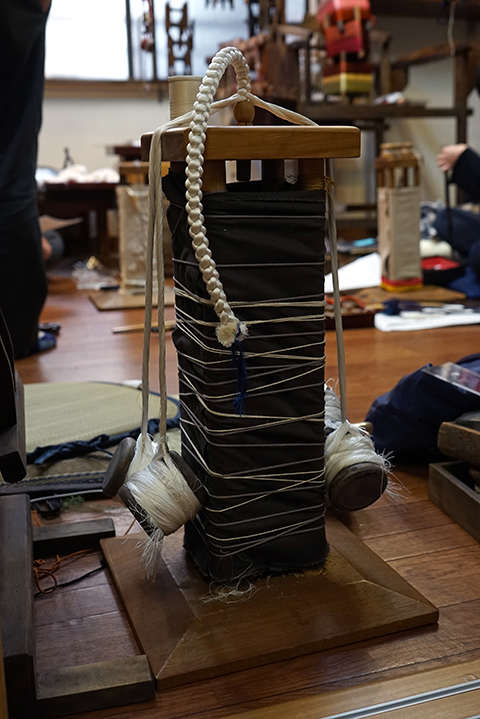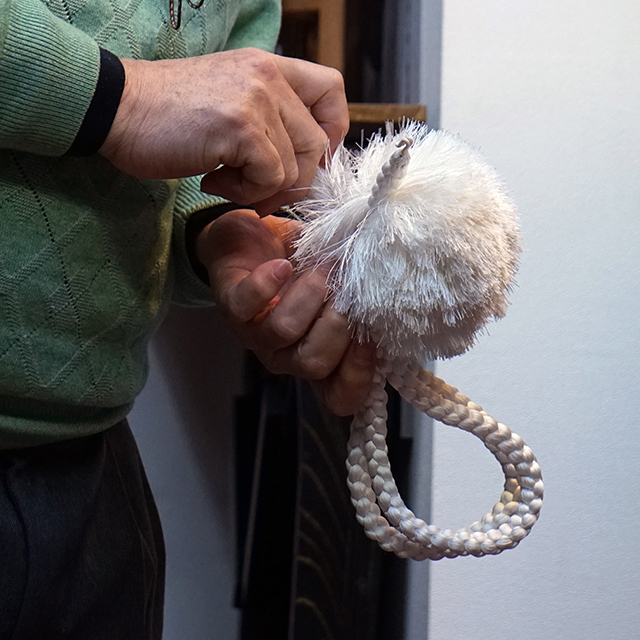
Kiryudo
Edo Kumihimo Kiryudo (Kiryudo Co., Ltd.) is a Kumihimo studio established in 1876. Its Kumihimo and Japanese miscellaneous goods store, located in Asakusa, Taito City, continuously attract tourists from home and abroad, and serves as a place to introduce Japanese craftworks. (1-32-12 Asakusa, Taito City)

A braiding method of Kumihimo using Kakudai. A large size cord for a Japanese half-coat is being braided.
The present-day Kumihimo is made with a variety of braiding methods, and has various uses. It is used for Japanese-style sash bands, Japanese half-coat cords, pouches, Japanese sword guards and accessories. Since many of Kumihimo products are braided by hand, it is slowly, carefully, and elaborately created. Depending on threads, colors and braiding methods, Kumihimo shows a variety of looks. Although there are various braiding methods both at home and abroad, "Kumidai," or braiding stand, is used in many methods. The following Kumidai and braiding methods are used:
Kakudai
Kakudai consists of a square shape upper board, a base board, a pulley from which braided cords are hung and other components. Although it is used for braiding methods with a small number of silk balls, it can be applied to a variety of braiding methods, including Yotsukumi (a basic braiding method using four silk balls), Yatsukumi (for round cords that are braided with eight silk balls), Marukarakumi (for round cords of which stitches are crossed), Hirakarakumi (for flat cords that are braided by the same method with Marukarakumi), and Kamogawakumi (a braiding method unique to Japan, which produces strong twists).
Marudai
It is Kumidai that consists of a circular upper board, legs and a base board. It has a structure in which braided cords are hung through a center hall of the upper board. Although it is not suitable for complex Kumihimo because the number of silk balls are restricted, it can be used for a variety of braiding methods, including simple ones to complex Karakumi. It is used to make Kanmurikumi (for Kumihimo used for crown cords), Marugenjikumi (for Kumihimo that expresses feather patters with different colors), Hiragenjikumi (flat Marugenjikumi), Yokakukumi (for Kumihimo that is braided around Yotsukumi Kumihimo like cedar leaves), Mitakekumi (a braiding method that combines Kakuyatsukumi and Yokakukumi), Karakumi (a variation of Sasanamigumi that expresses feather patters) and others.
Ayatakedai
It has a structure in which a fletchings-shaped bar is attached to a wooden frame. Cords are braided by stringing weft threads, inserting warp threads between above and below weft threads, and then driving in warp threads with a spatula. This Kumidai is suitable for making flat cords with various patterns.
Takadai
This is used for a braiding method called "Ayagaki," in which silk balls are hung on two spools attached to left and right sides of a large wooden frame. Cords are braided by driving in threads by a bamboo spatula. Patterns can be created by changing colors of two-tiered threads. It is suitable for creating complex patterns. A variety of braiding methods can be used on this stand, including Koraikumi (a braiding method for making minute and tight patterns), Yamatokumi (a method for making cords of which two sides have different colors and patterns), Sasanamigumi (a method for making wavelike patterns like bamboo grass leaves and waves), Kainokuchigumi (a method for making patterns that look like opened shells or honeycomb patterns), Andagumi (a method for making grid patterns), Naikigumi (a method that combines Andagumi on two sides), and Uneuchigumi (a method for making Kumihimo that interlinks Koraikumi). In many cases, this stand is used along with Marudai.
Naikidai
Cords are braided while rotating a leave-shaped board by gears, on which threads are hung. Although this stand, which is said to be developed in the Edo Period, can semi-automatically braid cords, in the present, it is scarcely used due to its complex structure.

Flat cords for Japanese half-coats

How to tie a Japanese half-coat cord

Kiryudo
Edo Kumihimo Kiryudo (Kiryudo Co., Ltd.) is a Kumihimo studio established in 1876. Its Kumihimo and Japanese miscellaneous goods store, located in Asakusa, Taito City, continuously attract tourists from home and abroad, and serves as a place to introduce Japanese craftworks. (1-32-12 Asakusa, Taito City)



















